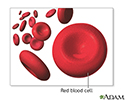Anemia caused by low iron - children
Anemia - iron deficiency - children
Anemia is a condition in which the body does not have enough healthy red blood cells. Red blood cells provide oxygen to body tissues. There are many types of anemia.
Iron helps make red blood cells and helps these cells carry oxygen. A lack of iron in the body may lead to anemia. The medical name of this problem is iron deficiency anemia.
Causes
Anemia caused by a low iron level is the most common form of anemia. The body gets iron through certain foods. It also reuses iron from old red blood cells.
A diet that does not have enough iron is the most common cause of this type of anemia in children. When a child is growing rapidly, such as during puberty, even more iron is needed.
Toddlers who drink too much cow's milk may also become anemic because too much cow's milk makes it difficult for the body to absorb iron. Also, children who drink too much cow's milk may not eat enough other healthy foods that have iron.
Other causes may be:
- The body is not able to absorb iron well, even though the child is eating enough iron.
- Slow blood loss over a long period, often due to menstrual periods or bleeding in the digestive tract.
Iron deficiency in children can also be related to lead poisoning.
Symptoms
Mild anemia may have no symptoms. As the iron level and blood counts become lower, your child may:
- Act irritable
- Become short of breath
- Crave unusual foods (pica)
- Eat less food
- Feel tired or weak all the time
- Have a sore tongue
- Have headaches or dizziness
With more severe anemia, your child may have:
- Blue-tinged or very pale whites of eyes
- Brittle nails
- Pale skin
Exams and Tests
Your health care provider will perform a physical exam.
Blood tests that may be abnormal with low iron stores include:
A measurement called iron saturation (serum iron level divided by the TIBC value) can help diagnose iron deficiency. A value of less than 15% supports the diagnosis.
Treatment
Since children only absorb a small amount of the iron they eat, most children need to have 3 mg/kg to 6 mg/kg of iron per day, in 1 to 2 doses per day.
Eating healthy foods is the most important way to prevent and treat iron deficiency. Good sources of iron include:
- Apricots
- Chicken, turkey, fish, and other meats
- Dried beans, lentils, and soybeans
- Eggs
- Liver
- Molasses
- Oatmeal
- Peanut butter
- Prune juice
- Raisins and prunes
- Spinach, kale and other green leafy vegetables
If a healthy diet does not prevent or treat your child's low iron level and anemia, your provider will likely recommend iron supplements for your child. These are taken by mouth.
Do not give your child iron supplements or vitamins with iron without checking with your child's provider. Your provider will prescribe the right kind of supplement for your child. Too much iron in children can be toxic. Supplemental iron is usually prescribed to be taken by mouth, but may also be given intravenously (through a vein).
Outlook (Prognosis)
With treatment, the outcome is likely to be good. In most cases, the blood counts will return to normal in 2 to 3 months. It is important that your provider finds the cause of your child's iron deficiency.
Possible Complications
Anemia caused by a low iron level can affect a child's ability to learn in school. A low iron level can cause decreased attention span, reduced alertness, and learning problems in children.
A low iron level can cause the body to absorb too much lead.
Prevention
Eating a variety of healthy foods is the most important way to prevent and treat iron deficiency.
References
Marcdante KJ, Kliegman RM, Schuh AM. Iron-deficiency anemia. In: Marcdante KJ, Kliegman RM, Schuh AM, eds. Nelson Essentials of Pediatrics. 9th ed. Philadelphia, PA: Elsevier; 2023:chap 150.
National Heart, Lung, and Blood Institute website. Iron-deficiency anemia. www.nhlbi.nih.gov/health/anemia/iron-deficiency-anemia. Updated March 24, 2022. Accessed February 22, 2024.
Rothman JA. Iron-deficiency anemia. In: Kliegman RM, St. Geme JW, Blum NJ, et al, eds. Nelson Textbook of Pediatrics. 22nd ed. Philadelphia, PA: Elsevier; 2025:chap 504.
Iron deficiency anemia
Animation
Hypochromia - illustration
Hypochromia
illustration
Formed elements of blood - illustration
Formed elements of blood
illustration
Hemoglobin - illustration
Hemoglobin
illustration
Review Date: 2/17/2024
Reviewed By: Charles I. Schwartz, MD, FAAP, Clinical Assistant Professor of Pediatrics, Perelman School of Medicine at the University of Pennsylvania, General Pediatrician at PennCare for Kids, Phoenixville, PA. Also reviewed by David C. Dugdale, MD, Medical Director, Brenda Conaway, Editorial Director, and the A.D.A.M. Editorial team.












